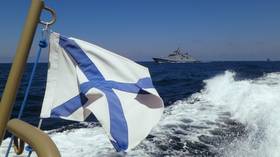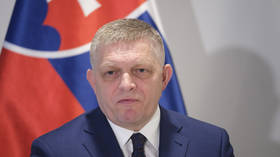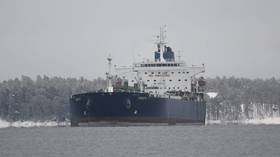Sea change: Building a naval base in Sudan is the first crucial step in restoring Russia’s maritime power

The Russian fleet needs a well-developed system of overseas military bases. Its planned logistics center on Sudan’s Red Sea coast is the first step – but one of exceptional significance.
On Monday, President Vladimir Putin ordered Russia’s defence ministry to conclude an agreement with Sudan on setting up a naval facility in the African country.
Last week, Prime Minister Mikhail Mishustin submitted a proposal to Putin on establishing a naval logistics center in Sudan, which would provide maintenance for Russian warships deployed to the region. According to the document, the city of Khartoum will grant a piece of its territory for the construction of the Russian base. The facility will accommodate up to 300 personnel and four vessels, including nuclear-powered ships.
Additionally, Russia will be able to use Sudan’s seaports and airports to transport in and out weapons, ammunition, and any equipment required to operate the base and “keep the warships mission-ready.” According to the agreement, the host country will collect no tolls or fees of any kind.
Also on rt.com Russia’s naval reach extends with new African base: Putin signs off on building Red Sea hub in strategically vital SudanBut the question is, how much does Russia need a naval base in Sudan?
The issue of establishing and improving naval bases to operate Russia’s fleet in foreign seas has always been a priority for the country’s military and political leadership. For example, before the end of World War I, it was agreed by the Allied Powers that the Russian Empire, as one of the victors, would receive the Turkish Straits (that is, the Bosphorus and the Dardanelles) and claim the port town of Bizerte in Tunisia, which would serve as a naval base for the Russian fleet in the Mediterranean.
At the Potsdam Conference of 1945, Soviet state leader Joseph Stalin sought trusteeship over Libya, formerly an Italian colony, which had joined the war on the side of the Axis Powers, Germany, Italy, and Japan. Had that happened, Moscow would have acquired important strongholds on the Mediterranean coast.
It should be noted, however, that the history of the Soviet Navy, when it comes to military bases and ports, has many tragic chapters. For one reason or another, most sites were lost, and, in many cases, there is no chance of reclaiming them.
Over the years, the Soviet Navy had fleet logistics centers, naval stations, and naval bases in Cuba (at Cienfuegos, where Soviet warships could use the mooring area and resupply; a number of floating workshops were also stationed there), Poland (Świnoujście), Germany (Rostock), Finland (Porkkalanniemi), Somalia (Berbera), Vietnam (Cam Ranh), Syria (Tartus), Yemen (Al Hudaydah), Ethiopia (Nokra), Egypt, Libya, and several other countries.
Also on rt.com Russia inks draft deal to open naval base for nuclear-powered ships in Sudan, in exchange for military cooperation with KhartoumKey Soviet naval bases and facilities abroad
Porkkalanniemi (Porkkala-Udd), Finland (1944-1956). By the mid-1950s, the Soviet leadership had decided it was time for the base to be closed down. Having little strategic importance, the Porkkala Naval Base served only to irritate the Finns and affect the relations between the two countries.
Vlore, Albania (1955-1962). The USSR had a brigade of 12 submarines based at the port of Vlore. In 1961, due to ideological differences, relations between Tirana and Moscow started to break down and the base was hastily evacuated. Four Soviet submarines undergoing repairs at the time were captured by the Albanians.
Berbera, Somalia (1964-1977). The Soviet Navy had a base on the shore of the Gulf of Aden. The construction of a deep-water port in Berbera was completed by 1969 and, in the early 1970s, the USSR chose the city as the place to build a runway for its naval aviation. Tupolev Tu-95RC and Ilyushin Il-38 aircraft were regularly based there. Reaching 4,140m in length, the runway was the longest in Africa at the time.
In 1977, following Somalia’s war with Ethiopia, the USSR lost control of its base in Berbera. The Soviet Navy was crippled in a strategically important area of the World Ocean, forced to abandon a harbor, an important communications hub, a tracking station, a tactical missile warehouse, a large fuel storage, and living quarters for one and a half thousand people. The United States immediately occupied the now vacant port of Berbera. The runway came under the control of the US military and, until the collapse of Somalia in 1991, it was listed as one of the reserve landing strips for America’s Space Shuttle missions.
Victoria, the Seychelles (1984-1990). In 1984, an agreement was reached with the leadership of the island state regarding Soviet ships touching at the port of Victoria, and Soviet military aircraft landing at the capital’s airport. Soviet warships regularly touched at the ports of Aden and Victoria in the Seychelles, but the USSR had no logistics centers or naval bases there.
Cam Ranh, Vietnam (1979-2002). The Cam Ranh naval base was considered one of the best locations in the Pacific Ocean in which to base warships and other vessels. At any given time, the Cam Ranh base housed 20 to 25 ships and vessels of the Soviet Navy, and about 40 reconnaissance aircraft, fighter planes, missile boats, and anti-submarine aircraft. The Soviet presence there posed a clear threat to any fleet in the region, from Hong Kong to Malaysia. In 2001, several years before schedule, the Russian Federation started to withdraw its military personnel from Vietnam. The last Russian servicemen left the Cam Ranh base in May 2002.
In addition, the warships of the Soviet Navy regularly entered Luanda (Angola), Conakry (Guinea), Bizerte and Sfax (Tunisia). Another fleet logistics center was operating on the island of Dahlak (Ethiopia). Shore facilities were constructed there, with floating workshops and floating docks stationed in the harbor area.
As for the anchorages near the Yemeni island of Socotra, it would be an exaggeration to classify these as fleet logistics centers, let alone naval stations or naval bases. Not only was there no port on Socotra, there wasn’t even a mooring area. There were no storage or other shore facilities, no Soviet airfields or communication centers – nothing at all.
The absence of a fully fledged system of naval bases in the zone of responsibility of the 5th Operational Squadron of the Soviet Navy (the Mediterranean Sea) resulted in warships and submarines having to spend significantly more time out of port. Lengthy navigations over the Mediterranean Sea and back required a lot of resources and, more importantly, took a toll on the ships’ systems.
In some cases, the problem was so acute that the navy’s leadership at the time had plans to create artificial islands that could serve as logistics support centers. The military scientific committee of the Soviet Navy was tasked with solving the issue.
Most of the Soviet sailors, however, relied on whatever means and tactics they could come up with to offset the unfavorable conditions. For example, they developed ways of organizing ‘drifting’ makeshift bases in the ocean. Floating bases and support vessels were used in areas where the sea was generally calm, and near sea-ice edges.
Another method involved using deep-sea drift anchors or heavy mooring equipment (barrels with multiple anchors weighing over 75 tons) in waters up to 300 meters deep and with wind speed no more than six or seven on the Beaufort scale. Another potential solution was to install floating ocean platforms at depths of up to 100 meters.
Also on rt.com Putin promises unrivalled tech & weapons for Russian military as Navy Day marked with showcase parades (PHOTOS, VIDEO)A Sudan base is just the first step
Sooner or later, Russia will face the challenge of restoring itself as a maritime power. It will regain economic might, military strength, and international status and respect. Therefore, the Russian Navy needs a well-developed system of naval bases worldwide.
Located at the crossroads of international trade routes – key transportation arteries pass through this hub, from Europe, through the Suez Canal, into the Red Sea and the Indian Ocean, and further into Asia and Australia – a base in Djibouti will give Russia vastly improved access to the Indian Ocean.
It will mean better security of strategic sea routes in many parts of the World Ocean, and expansion of military-political and military-technical cooperation with countries of the region. It will provide repairs, resupply operations, and rest for crew members. The new logistics center in Sudan is just the first step, but one of exceptional significance.
Like this story? Share it with a friend!
The statements, views and opinions expressed in this column are solely those of the author and do not necessarily represent those of RT.















